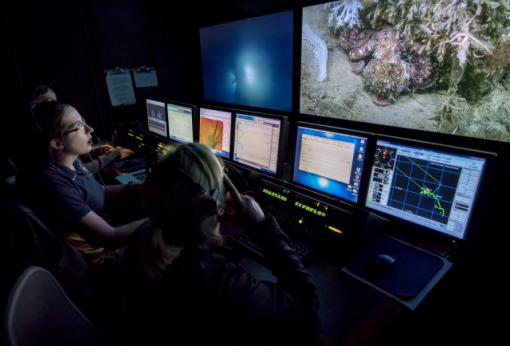Data Management
Once an expedition ends, data and specimens live on in the laboratories of researchers, the archives of data centers, and the repositories of institutions. Although researchers on board and ashore sometimes recognize an exciting new discovery immediately, most discoveries will occur long after explorers return from sea. As such, Ocean Exploration Trust contributes data, video, and samples gathered on expeditions to multiple public archives to ensure it will be available for decades to come.

The video, data, and samples that result from our expeditions are available to any interested researcher immediately through our OET Data & Video Request Form. These requests are typically filled electronically by a weblink to the dataset requested at no cost. Some cost may be associated with hardware, shipping and personnel time for complex or large video requests that are delivered by mail on multiple harddrives in a RAID device.
Digital Data Structure
Data collected during Nautilus expeditions are saved in a standard data structure. This structure and the various files from different systems are described in our Data User Guide. Standard data also includes a set of standard data products such as Dive Reports and Sample Reports. These products are generated automatically and then supplemented by scientists on the ship. Occasionally, there is an error recognized in the data or a new data product created after an expedition ends. Any additions or corrections to data products after the end of the cruise are located in the expedition’s “Addendum” directory.
Data Archiving
Inclusion in well-known archives is critical as it is likely that researchers years from now will make discoveries from the standard datasets we collect on our expeditions. Full datasets are sent to the Rolling Deck to Repository facility for long-term archival, visibility to researchers, and accessibility via dissemination to appropriate data repositories.
Seafloor Mapping Data
Seafloor mapping data is available from the National Centers for Environmental Information. Mapping data is also attributed to the global bathymetry grids, such as the GEBCO project, Seabed 2030, which aims to produce a complete map of the seafloor by 2030. Much of our data is collected from remote places, which will otherwise go unmapped for years to come.
ROV Video Footage
Additional access to the satellite recordings of full ROV dives can be found on our Dive Recordings page on YouTube since 2019.
Biological Samples
So little is known about the inhabitants of the deep-sea, that discoveries of new species or range extensions of organisms are quite common. Whole specimens and tissue sub-samples for DNA analysis are housed at Harvard University’s Museum of Comparative Zoology since 2013. Samples are available to researchers by request. In the "Collector" box enter "Nautilus" to find samples. Use the "Berkeley Mapper" option on the results page to view specimens geographically.
Geological Samples
Geological rocks and short sediment cores are available to researchers by request from the Marine Geological Samples Lab at the University of Rhode Island’s Graduate School of Oceanography. To find Nautilus samples, expand the Set Name/IGSN box, choose Sample Name/Number “contains,” and enter the cruise number (e.g. "NA101"). The search will return a button with a number of samples available, which can be clicked to display a full list. There are links at the top of the list to download all sample data or view on a map. Clicking a sample link provides individual sample record information.
